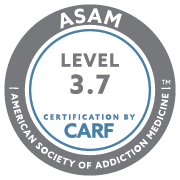For years, scientists have been trying to determine the exact connection between alcohol and obesity. While this is still not entirely clear, there is evidence that suggests a link between the two. So, how do drugs and alcohol lead to obesity?
One theory is that alcohol can interfere with the body’s ability to burn calories. In fact, one study found that alcohol consumption was associated with increased waist circumference and a higher risk of obesity. Additionally, alcohol can contain a lot of empty calories, which can contribute to weight gain over time.
What Is Obesity and What Causes It?
When someone is obese, it means they have too much body fat. Obesity is a major health problem in the United States, and it’s becoming increasingly common among adults and children. According to the Centers for Disease Control and Prevention (CDC), more than one-third of American adults are obese, and 17 percent of children and adolescents are obese.
Non-Hispanic Black adults (49.6%) had the highest age-adjusted prevalence of obesity, followed by Hispanic adults (44.8%), non-Hispanic White adults (42.2%), and non-Hispanic Asian adults (17.4%). The obesity prevalence was 40.0% among adults aged 20 to 39 years, 44.8% among adults aged 40 to 59 years, and 42.8% among adults aged 60 and older.
Obesity is associated with a number of serious health problems, including heart disease. Another possible explanation is that people who drink or use drugs may be more likely to engage in unhealthy behaviors like eating junk food or not exercising.
Alcohol and drugs may play a role in becoming obese, but alcohol is not an independent cause of obesity. If alcohol use is causing weight gain, it is likely because alcohol replaces other food or nutrients that would otherwise be eaten; alcohol also adds excess calories for those who drink heavily (more than three drinks per day). Although alcohol’s specific causal role in obesity has yet to be determined, alcohol use linked with poor diets and lack of exercise can exacerbate one’s risk for obesity.
How Is Obesity Defined?
Obesity is defined as having an unhealthy amount of body fat. The most commonly used measure to define overweight and obesity in adults comes from Body Mass Index (BMI). The BMI is a measure of weight in relation to height. BMI provides a reliable indicator of body fatness for most people and is used to screen for weight categories that may lead to health problems.
Being overweight or having obesity increases a person’s risk for several diseases and health conditions including type 2 diabetes, high blood pressure, coronary artery disease, stroke, gallbladder disease, osteoarthritis, and sleep apnea. In addition, many cancers have been linked with being overweight or obese. Research shows that even modest weight loss can reduce the risk factors associated with these diseases and conditions while increasing life expectancy.
Obesity is commonly associated with alcohol abuse because alcoholics are more likely to be overweight or obese than people who do not abuse alcohol. It is not known if alcohol abuse causes obesity, or if people who are obese are more likely to become alcoholics. However, it is clear that there is a strong link between the two conditions. People who abuse alcohol tend to have unhealthy eating habits, and they are more likely to consume high-calorie foods and drinks. They are also less likely to engage in physical activity, which can lead to weight gain.
What Are the Risk Factors of Obesity?
The risk factors of obesity include:
- Genetics
- How your brain functions
- Environmental/developmental risk factors
- Medical history
- Social Pressure or Stigma
- The quality of your life
- Age
Obesity is most common among adults aged 40 years and older. Researchers believe that this pattern is related to changes in the body as people age, including metabolic, hormonal, and behavioral changes. Diet patterns shift with age too; alcohol intake may decrease but calorie intake typically increases. Furthermore, alcohol abuse can also cause age-related diseases such as Alzheimer’s disease, which affects brain function and memory.
Americans spend less time on housework than ever before. Today, most Americans work more than 40 hours per week at their job and spend about 14 hours per week watching television. They also get more of their calories from fast food than fresh produce. All these factors can contribute to obesity.
Similarly, alcohol abuse can lead to a sedentary lifestyle. Alcoholics are often too tired to exercise, and drinking increases the risk of injuries that can prevent activity. In fact, alcoholics are at high risk for cirrhosis (liver disease), pancreatitis (inflammation of the pancreas), and various types of cancer, all of which can reduce life expectancy.
How Do Drugs, Alcohol, and Obesity Relate to One Another?
This is a question that has puzzled researchers for years. Although the answer is not completely clear, there are several theories about how these three behaviors are connected. One theory is that alcohol abuse can lead to obesity. This may seem counterintuitive since alcohol is often thought of as a “calorie-free” drink.
However, alcohol can actually cause weight gain in several ways. First, alcohol can increase your appetite and make you eat more than you would normally. Second, alcohol can slow down your metabolism, making it harder to burn calories. Finally, alcohol contains empty calories that contribute to weight gain.
Another theory is that people who are obese are more likely to abuse drugs and alcohol. This may be due to the stigmas related to obesity. People who are obese often experience discrimination and exclusion and may try to cope with these feelings by using alcohol and drugs. However, it is important to note that there isn’t any evidence showing that alcohol or drug use causes obesity in the general population — only in alcoholics.
A third theory is that certain groups of alcoholics can develop obesity as a result of their alcohol abuse. These alcoholics generally come from low socioeconomic backgrounds, which could contribute to their weight problems.
How Does Alcoholism and Weight Changes Affect Women vs. Men?
The National Institute on Alcohol Abuse and Alcoholism (NIAAA) reports that women are more likely to become alcoholics than men, and women are more likely to experience alcohol-related health problems at lower levels of alcohol consumption than men. For example, a woman’s risk for liver cirrhosis increases significantly after only two drinks per day, while a man’s does not increase until after four drinks per day.
In addition, alcohol abuse can lead to weight gain in women. Studies have shown that alcohol can stimulate the appetite and contribute to increased caloric intake. In fact, one study found that women who consumed one or more alcoholic beverages per day were significantly more likely to be overweight or obese than women who did not partake in alcohol consumption.
However, alcohol consumption also leads to weight loss because it interferes with the utilization of glucose for energy. As a result, alcoholics tend to be thinner than those who don’t drink. However, alcohol abuse can lead to both undernutrition and malnutrition as well as conditions such as Wernicke-Korsakoff syndrome that affect food intake.
Although alcohol consumption has been linked to obesity in women, data indicate that alcohol use is not associated with weight gain in men. It’s unclear why alcohol does not contribute to obesity in men; however, experts believe that alcohol may preserve lean body mass more effectively than fat. It is important to note that individuals who are obese are at greater risk for alcohol-related problems.
Does Alcoholism Cause Obesity (Directly or Indirectly)?
Alcoholics are more likely to have an alcohol use disorder. The abuse of alcohol is related to alcohol dependence. Alcoholism can present adverse effects to the body, which might contribute to obesity in people who are alcohol-dependent.
Alcohol intake interferes with weight management because alcohol interferes with one’s ability to metabolize nutrients through the liver. Additionally, alcohol also has a high caloric value (7 calories per gram), and its consumption can stimulate the appetite. Alcoholic beverages are often high in sugar and carbohydrates which can contribute to weight gain.
These adverse effects include liver abnormalities, vitamin deficiencies, cardiovascular disease, inflammation of the stomach lining, etc. As found by one study, alcoholics had a lower basal metabolic rate than non-alcoholics.
In fact, it has been seen that alcoholic beverages like beer and wine contain low amounts of antioxidants, which could lead to oxidative stress and degenerative disorders including cancer and diabetes. Alcoholic beverages also act as diuretics, leading to increased work for the kidneys and liver.
Can weight problems cause individuals to turn to substance abuse to self-medicate, leading to addiction? Weight changes can occur for a variety of different reasons. Like alcohol, drugs have a variety of pharmacological actions on the human body.
There are many different theories about how alcohol and other drug use manifest, but most experts agree on a biopsychosocial model. This means that biological factors (genetics, gender, age), psychological factors (mental health disorders), and social influences all play an important role in substance abuse later down the line.
Drinking alcohol increases your risk for liver cirrhosis, cancer of the mouth cavity, etc. Smoking causes lung cancer and diseases like emphysema etc. Marijuana causes alteration in senses, leading to dry mouth which can be self-medicated using sugary drinks, thus increasing the risk for obesity.
Is There Treatment for Addiction and Obesity?
Treatment for addiction and obesity is difficult, but not impossible. The key is to address all of the underlying factors that contribute to addiction and obesity.
Drugs, alcohol, and obesity are all major public health concerns in the United States. Each of these conditions can lead to serious health problems, including addiction and obesity. There is a lot of overlap between alcohol addiction and obesity. For example, alcohol can cause weight gain by increasing appetite and slowing down the body’s metabolism. Alcohol also contains empty calories.
Treatment may include:
- Counseling or therapy
- Biological interventions, such as medications or supplements
- Psychological treatments, such as cognitive behavioral therapy
- Lifestyle changes, such as diet and exercise
- Social support
It’s important to seek help from a qualified professional if you are struggling with addiction or obesity. There is no one-size-fits-all solution, but with the right treatment plan, you can overcome these challenges and live a healthier life. Alcohol and obesity can introduce many challenges.
Rehab programs can help people struggling with alcohol addiction to get sober and stay sober. Likewise, obesity surgery can help people struggling with obesity to lose weight and keep it off. However, these treatments only work if the individual is willing to make changes in their lifestyle and behavior.
Inpatient Treatment
Inpatient or residential treatment is one way to address alcohol addiction and obesity together. When a person is admitted to an inpatient alcohol treatment center, they will likely receive treatment for 30, 60, or 90 days. Inpatient treatment programs are the most comprehensive. Residential treatment programs for substance use are designed to be a distraction-free environment to focus on recovery. These programs typically include counseling and therapy sessions, as well as support groups for people who are trying to overcome alcohol addiction.
Outpatient Treatment
Outpatient treatment for alcohol addiction and obesity can be helpful for people who are not able to take time off from work or school to attend an inpatient program. These programs also offer more flexibility, which can be helpful for people who have busy lives. The average length of time spent in outpatient treatment is 30 days. A patient can anticipate spending a few days a week at an outpatient treatment center.
Outpatient treatment programs offer psychotherapy, among other services to help you recover. Outpatient treatment programs are best suited for those with mild to moderate cases of addiction. Intensive outpatient treatment (IOP) programs are a notch up from outpatient treatment but provide the structure of inpatient treatment.
Dual Diagnosis Treatment
Dual diagnosis treatment can be effective in treating co-occurring disorders. Co-occurring disorders can be described as a combination of a substance use and mental health disorder. It’s important to treat both to ensure proper quality care for the person. Many individuals use substances to self-medicate underlying conditions.
This type of alcohol treatment will address both alcohol addiction and obesity. To be admitted to a dual diagnosis alcohol treatment center, you need to have at least one other disorder in addition to alcohol dependence. This could include things like depression, anxiety, bipolar disorder, schizophrenia, etc.
However, some alcohol treatment programs are set up for people who don’t meet the criteria for alcohol addiction but still struggle with weight issues. These programs can help you get control of your eating habits and figure out healthy ways to live. They’re also usually very affordable since they don’t require an extensive evaluation period or intensive therapy.
Holistic Addiction Treatment
Drugs, alcohol, and obesity are all linked together in a variety of ways. Alcohol also slows down the body’s metabolism, making it harder to burn off those extra calories. Additionally, alcohol can interfere with the body’s ability to regulate food intake, causing people to eat more than they normally would.
Recovering individuals may relate to the alternative methods of holistic addiction treatment. Holistic addiction treatment has become popular, due to the highlight on the whole person. Holistic addiction treatment emphasizes mindfulness, art, and nutrition therapy. Malnourishment is common with those with a substance use disorder. Although the efficacy of holistic addiction treatment is inconclusive, the patient satisfaction has been improved from the addition of holistic therapies with evidence-based treatment.
Aftercare
Aftercare programs, which can involve sober living homes, can be wonderful resources for all stages of addiction. They provide a supportive, alcohol-and drug-free environment where people can learn how to live without alcohol or drugs. Sober living homes provide a safe and supportive environment for people who have recently completed alcohol or drug rehab. In a sober living home, residents are typically required to abstain from alcohol and drug use.
Enrich Your Life Through New Directions for Women
The stigmas surrounding alcohol and obesity can leave you feeling hopeless. Discovering help for a substance use disorder requires patience and determination. There are plenty of resources available to you today. You do not have to endure these obstacles alone. The staff at New Directions For Women aim to inform and rewrite your relationship to alcohol and obesity. If you or a loved one are struggling with addiction, contact us today.
References:
https://www.cdc.gov/nchs/products/databriefs/db360.htm
https://www.cdc.gov/obesity/data/adult.html
https://www.utsouthwestern.edu/newsroom/articles/year-2021/pandemic-increases-substance-abuse.html












